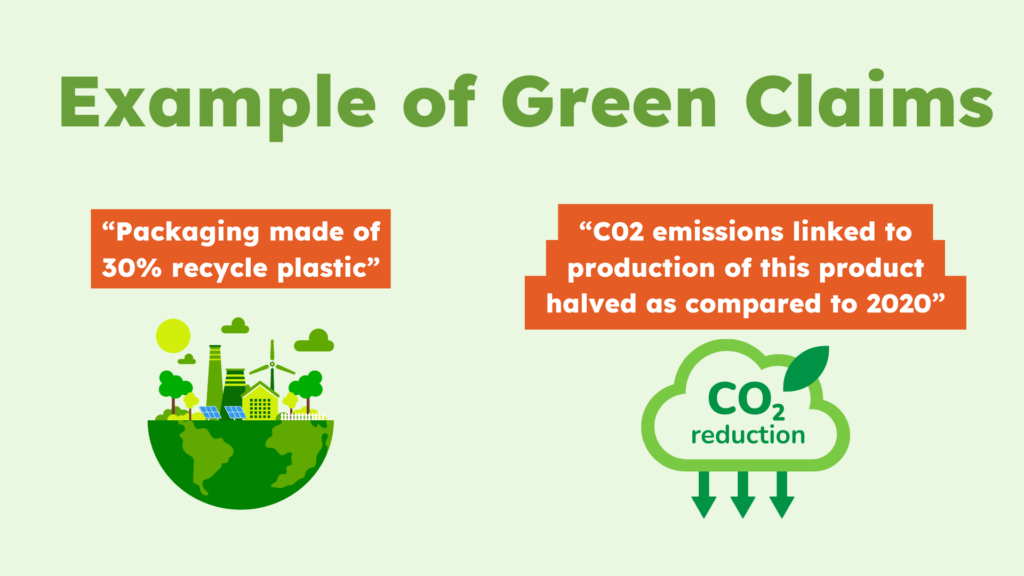GCD
Green ClaimsClaims Directive
What is the Green Claims Directive?
The Green Claims Directive is a proposed European Commission directive to counter greenwashing, ensuring that made in environmental claims by businesses in relation to their products or services are accurate, transparent and verifiable. As part of the European Green Deal and Circular Economy Action Plan it aims to promote sustainable consumption that enables consumers to make informed environmentally-friendly choices. Through aligning environmental claims the directive aims to promote trust and transparency, prevent misleading information / fair market and the EU’s broader climate and environmental ambition.
The EU is looking to strengthen its position in regulating the spread of false or deceptive environmental claims, or greenwashing. In a move to crackdown on a growing practice by companies exaggerating the green credentials of products, services or overall operations and to help establish a fair market place which is also sustainable, regulators are considering a ban on misleading environmental claims unless companies can evidence their statements with a complete analysis.
The aim of the Green Claims Directive (GCD or the Directive) is to prevent the green transition being hampered by greenwashing. Under the GCD, only companies with verified environmental claims will be permitted to derive commercial advantage of using green claims. The GCD and related greenwashing regulations could prompt an increase in greenwashing litigation globally.
The GCD focuses on those clear and explicit environmental claims that companies make about their products or themselves in business-to-consumer practices. It sets out the conditions for ensuring the control and the transfer of information on these environmental claims along with the specific criteria for the approval of environmental labels, third-party certifications and penalties in case of non-compliance.
On 12 March 2024, the European Parliament adopted its position setting out its vision concerning the scope of claims to be covered, the detailed requirements on how to substantiate the claims and the deadline for the implementation. The proposal will move forward following the European Parliament elections early June. If an agreement is reached between the European Parliament and Council of the European Union, EU Member States shall introduce the Directive into national law within 24 months, with enforcement kicking off for 36 months.
To remain up to date, click here.

How did it all start?
A substantial proportion of green claims on products and services today lacks reliability and clarity, raising significant concerns about transparency in sustainability messaging. Studies reveal that 53% of green claims are either vague, misleading, or completely unfounded, suggesting that consumers are often presented with environmental information that lacks substance or is designed to create a false impression of sustainability.
Additionally, 40% of these claims provide no supporting evidence, which underscores the widespread issue of greenwashing—where businesses make unsubstantiated environmental promises to enhance their market appeal. These findings emphasize the critical need for stricter regulatory standards, more robust verification processes, and greater corporate accountability to ensure that sustainability claims are both trustworthy and informative, ultimately protecting consumers and fostering genuine progress towards environmental goals.
Scope of the Green Claims Directive
The Green Claims Directive is relevant to all businesses operating in the EU that communicate environmental claims about their products, services, or their corporate brand. This encompasses a broad range of sectors, with the most common being:
- Manufacturing: Manufactures of goods which provide information about the environmental performance of their products, using claims like “eco-friendly”, “biodegradable” or “sustainable”.
- Retail: Retailers who sell products with environmental claims on the packaging or in promotional material.
- Financial Services: Financial institutions offering green investment products or services using terminology like environmentally friendly or sustainable.
- Hospitality and Tourism: Businesses within the hospitality industry claiming to offer environmentally-friendly services, such as green hotels and eco-tourism.
- Consumer Goods and Services: Any company that makes environmental claims about the packaging, use, or disposal of their products.
The directive considers all forms of explicit and implicit green claims whether visual (such as through the use of eco-labels and certifications) or verbal or written. This broad scope ensures that all types of communication that may shape consumer perception of environmental impact is covered by the legislation.

Timeline for Implementation
1. Proposal by the European Commission
The European Commission formally proposed the Green Claims Directive on March 22, 2023.
3. Approval by the EU Parliament
The European Parliament votes on the proposed directive, expected in late 2024 or 2025.
6. Transposition into National Law
EU Member States will have two years to transpose the directive into national law.
2. Public Consultation
The European Commission conducted a public consultation to gather input from stakeholders.
5. Adoption of the Directive
Once approved by Parliament and the Council, the directive will be adopted, likely in 2025.
Comply with the Green Claims Directive
| Step | Description | Action Items |
|---|---|---|
| 1. Understand the Directive’s Requirements | Familiarize yourself with the Green Claims Directive’s scope, objectives, and requirements. Review all explicit and implicit claims related to your business. |
|
| 2. Conduct a Life Cycle Assessment (LCA) | A systematic analysis of the environmental impact of a product or service throughout its life cycle, from material extraction to disposal. |
|
| 3. Ensure Claims are Specific and Transparent | Claims must be clear, precise, and backed by specific information related to the environmental benefits substantiated by the LCA. |
|
| 4. Engage in Third-Party Verification | Independent verification is essential to demonstrate the validity of your environmental claims and compliance with the directive. |
|
| 5. Develop and Implement Internal Policies and Procedures | Establish internal policies on environmental claims, assign responsibilities, and ensure training for employees involved in compliance. |
|
| 6. Maintain Comprehensive Documentation | Proper documentation is critical to demonstrating compliance and will be essential during the verification process. |
|
| 7. Stay Informed and Proactive | Monitor regulatory changes, engage with industry experts, and leverage tools to streamline compliance and stay ahead of new requirements. |
|
Overview of the Green Claims Directive
The upcoming Green Claims Directive (GCD) will strengthen and operationalize the European Parliament’s recently adopted ban on greenwashing under the “Empowering Consumers for the Green Transition” Directive, which seeks to improve available product information on durability and reparability, protect against greenwashing and premature obsolescence, and promote repair services.
The GCD will require businesses to verify the basis for any claim they publish about the environmental benefits of their products, thus providing consumers with transparent, trustworthy, and meaningful information. The directive will specify how environmental claims should be verified, such as by assessing the environmental impacts of a product throughout its life cycle, using scientific evidence, and providing explanations for divergent results between legal and sectorial benchmarks.
Businesses must disclose this information alongside the product, often through a URL or QR code. The disclosed information is expected to include:
- Environmental aspects, impact, and performance referenced in the claim
- Relevant EU or international standards used for substantiation
- How improvements related to the claim were achieved
- Information on greenhouse gas (GHG) offsetting, if applicable
- Studies or calculations used to assess, measure, or monitor impacts
- Certificates of conformity
- Comparative data, in cases of comparative advertising
The rules emphasize the need for careful consideration of the environmental significance, balance, and accuracy of claims, to prevent businesses from publishing misleading or unbalanced environmental information.
Governance and Labels
The GCD also sets mandatory governance requirements for environmental claims, including a transparent governance structure, the participation of stakeholders and the systematic procedure for handling or review of complaints and disputes, and for review of non-compliance with criteria for the use of the label.
Third-Party Verification
Environmental claims and labels will be subject to independent verification. EU Member States must establish verification procedures to guarantee the truthfulness and accuracy of such claims. Verifiers will issue certificates of conformity which confirm that claims are in conformity with the Regulation.
While the verification process is intended to secure the compliance, certified compliance does not give immunity to civil liability or regulatory control. Public authorities may carry out verifications through market surveillance, including company audits and also publish reports on the compliance of companies with the GCD.
Noncompliance Penalties
The GCD also creates a system for resolving disputes and complaints filed by victims of false environmental marketing, including individuals, businesses and other organizations.
For companies found noncompliant, potential penalties include:
- Fines: Fines must eliminate any financial gains from the violation, with a maximum fine of 4% of annual turnover, increasing for repeated offenses.
- Revenue Confiscation: Authorities may confiscate any revenue earned from products associated with false environmental claims.
- Temporary Exclusion from Public Procurement: Noncompliant companies may be barred from public procurement and funding opportunities for up to 12 months, including exclusion from tendering processes, grants, and concessions.
European Parliament Amendments
The European Parliament introduced several key amendments to strengthen consumer protection against misleading marketing:
- Noncompliant companies will have 30 days to take corrective actions, with the possibility of extension only in exceptional cases.
- Verifiers must evaluate claims and supporting evidence within 30 days, with simpler claims potentially qualifying for faster verification.
- Micro-enterprises remain exempt from the proposed rules, while small and medium-sized enterprises (SMEs) may receive an additional year to achieve compliance.
- The use of carbon offsetting as the basis for green claims remains restricted, although green claims for products containing hazardous substances are still permissible.
Scope:
Focuses on both product-level and company-level claims related to environmental performance.
Harmonization:
Ensures uniform criteria across the EU for evaluating environmental claims.
Sanctions:
Introduces penalties for non-compliance to deter false claims.
Transparency:
Requires companies to substantiate their green claims with scientific evidence.
Consumer Protection:
Aims to protect consumers from misleading or vague claims like "eco-friendly" without proof.
Why should you work with T3 Consultants?
Proven Track Record
- T3 Consultants can rely on a proven expertise in regulatory compliance and risk management. Our know-how in the financial services industry enables to create strong, dependable and lean compliance infrastructure for the Green Claims Directive.
Multidisciplinary Team of Experts
- Our team includes regulatory experts, lawyers, environmental scientists, and marketing specialists, providing an all-encompassing solution for your compliance requirements. Taking advantage of our multi-disciplinary know-how, we can offer integrated solutions that take into account all aspects of the Green Claims Directive.
Customized Approach
- We understand that each business is unique. Our customized approach ensures that our solutions are tailored to your specific business model, industry, and target audience, providing the best possible outcomes.
Commitment to Sustainability
- At T3 Consultants, we are committed to promoting sustainable practices. Our services not only ensure compliance but also help you position your brand as a leader in sustainability.
Want to hire
Green Claims Directive Expert?
Book a call with our experts
